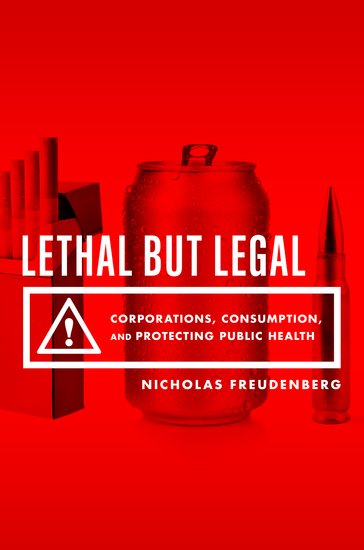The Guardian: my thoughts on food companies’ taking out the negatives
Here’s my piece from The Guardian, April 2, 2016.
Here’s my piece from The Guardian, April 2, 2016.
With Simon Williams, I have just co-edited a special issue of Critical Public Health: “Big Food”: Critical perspectives on the global growth of the food and beverage industry.”
Here’s what’s in it.
Editorial
Commentaries
Thanks to Simon Williams for initiating (and doing the heavy lifting on) this project, and to all the terrific contributors.
Enjoy!
I gave a talk last week at Hastings College in Hastings, Nebraska.
Before I left, Michael Moss, who wrote the New York Times investigative report about Hasting’s USDA animal research facility, mentioned the Kool-Aid museum.
The Kool-Aid museum?
As it happens, I adore museum exhibits devoted to single food items. The Hastings Museum houses a permanent collection of Kool-Aid historical materials and artifacts.

A Hastings resident, Edwin Perkins, invented this product in 1927.
Kool-Aid, in case this isn’t on your usual shopping list, is a flavored and colored powder that comes in small packets. You add the 4.6 gram contents—plus one full cup of sugar—to two quarts of water.
What’s in the packets? I was given a cherry limeade flavor: contains citric acid, maltodextrin, calcium phosphate, vitamin C, natural and artificial flavor, salt, artificial color, red 40, tocopherol [a form of vitamin E], BHA, and BHT (preservatives).
The less said about nutritional value, the better.
But take a look at its corporate history:
I loved the exhibit, even though you have to go through rooms full of guns to get to it.
The exhibit didn’t mention the Jonestown massacre, the source of the phrase “drinking the Kool-Aid” because Kool-Aid was not involved.
It’s a slow news week so I’m digging in to some items saved over the course of the year.
Here’s one from The Hartman Group, a market-research consulting firm: “Why [software] investors are pouring their lettuce into food.”
The article is about start-ups funded by software billionaires, but its point—there’s money to be made in food—reminds me of Fred Kaufman’s work on food commodity trading.

Making money from food is good when it keeps people employed and pays living wages.
It’s not so good when it adds to world hunger.
Everybody agrees that the packaged food industry isn’t selling as much as it used to. Here are three explanations for this trend.
1. The packaging: The Wall Street Journal says it’s all about the old-style packaging that makes foods seem unnatural. Clear packaging works better for sales.
2. More sophisticated consumers: The Hartman Group research and consulting firm has a new report analyzing this trend: “Recipe for Growth in Packaged Foods:”
The biggest long-term challenge facing the U.S. food industry is that taste preferences are changing. This is most apparent among highly urbane and educated consumers, where the arbitrary boundaries of “too sweet” and “too fatty” are altering in ways inimical to the core food science paradigm of the U.S. food and beverage industry.
The U.S. food industry routinely serves crude flavor profiles associated with the unsophisticated farm cuisine of Middle America: heavy on salt, dairy and animal fat and, in the past half century, sugar…For years, there was growing demand for these flavors in all sorts of foods, primarily because U.S. preferences were not changing.
Now they are. The increasing multiculturalism of the U.S. population plus the globally well-traveled, savvy upper-middle class have created a large population of consumers intentionally seeking complex flavor profiles imported from much more sophisticated food cultures.
3. Not enough corporate social responsibility: Oxfam’s Behind the Brands campaign achieved two coups in the last week or so. First General Mills and now Kellogg have signed on to its Climate Declaration which commits them to reducing greenhouse gases produced in their processing chains. Oxfam organized more than 200,000 signatures on a petition—and produced a report, Standing on the Sidelines—to induce these companies to pay more attention to their effects on climate change.
Food advocacy is making headway. Keep at it!

I spoke last night on a panel celebrating the release of this book. I gave it a rave blurb:
Lethal But Legal is a superb, magnificently written, courageous, and thoroughly compelling exposé of how corporations selling cigarettes, guns, cars, drugs, booze, and food and beverages enrich themselves at the expense of public health. Even more important, Freudenberg tells us how we can organize to counter corporate power and achieve a healthier and more sustainable environment. This book should be required reading for anyone who cares about promoting health, protecting democratic institutions, and achieving a more equitable and just society.
I will be using this one in classes. Congratulations to Nick Freudenberg, director of Hunter College’s Food Policy Center, for producing this distinguished work of scholarship.
I’ve just been sent a copy of the opening address given by the Director-General of the World Health Organization, Dr Margaret Chan, to a Global Conference on Health Promotion in Helsinki on June 10.
Here is an excerpt from her extraordinary remarks:
Today, getting people to lead healthy lifestyles and adopt healthy behaviours faces opposition from forces that are not so friendly. Not at all.
Efforts to prevent noncommunicable [chronic] diseases go against the business interests of powerful economic operators.
In my view, this is one of the biggest challenges facing health promotion…it is not just Big Tobacco anymore. Public health must also contend with Big Food, Big Soda,and Big Alcohol.
All of these industries fear regulation, and protect themselves by using the same tactics.
Research has documented these tactics well. They include front groups, lobbies, promises of self-regulation, lawsuits, and industry-funded research that confuses the evidence and keeps the public in doubt.
Tactics also include gifts, grants, and contributions to worthy causes that cast these industries as respectable corporate citizens in the eyes of politicians and the public.
They include arguments that place the responsibility for harm to health on individuals, and portray government actions as interference in personal liberties and free choice.
This is formidable opposition. Market power readily translates into political power…
Not one single country has managed to turn around its obesity epidemic in all age groups. This is not a failure of individual will-power. This is a failure of political will to take on big business…
I am deeply concerned by two recent trends.
The first relates to trade agreements. Governments introducing measures to protect the health of their citizens are being taken to court, and challenged in litigation. This is dangerous.
The second is efforts by industry to shape the public health policies and strategies that affect their products. When industry is involved in policy-making, rest assured that the most effective control measures will be downplayed or left out entirely. This, too, is well documented, and dangerous.
In the view of WHO, the formulation of health policies must be protected from distortion by commercial or vested interests.
Dr. Chan was courageous to say this so clearly. Would that our health officials would be as brave.
Americans these days don’t want artificial and unsustainably produced ingredients in the food they buy and eat. For the makers of highly processed foods – ultraprocessed in today’s terminology – there isn’t a lot that they can do to make the products appear fresh and natural.
But Campbell’s is certainly trying. A few months after announcing that it will phase out genetically modified organisms (GMOs), the iconic soup company said on Friday that it will remove Bisphenol-A (BPA) from its cans by next year.
BPA, you will recall, is a chemical typically used in polycarbonate plastic containers and in the epoxy linings of food cans. It’s also an endocrine disrupter, which means it can interfere with the work our hormones are doing. Some research finds BPA to have effects on childhood development and reproduction.
Although the FDA doesn’t believe evidence of potential harm is sufficient to ban BPA from the food supply, the agency discourages use of BPA-polycarbonate or epoxy resins in baby bottles, sippy cups or packaging for infant formulas. For the past year or so, other retailers have been working hard to phase out BPA and to reassure customers that their cans and packages are safe.
All of these companies sell highly processed foods in an era when the public is demanding – and voting with their dollars – for fresh, natural, organic, locally grown and sustainably produced ingredients.
They can’t provide those things, but they can tout the bad, or unpopular, things that aren’t part of their product, the “no’s”: no unnatural additives, no artificial colors or flavors, no high fructose corn syrup, no trans fat, no gluten and, yes, no GMOs or BPA.
Let me add something about companies labeling their products GMO-free. In my view, the food biotechnology industry created this market – and greatly promoted the market for organics, which do not allow GMOs – by refusing to label which of its products contain GMOs and getting the FDA to go along with that decision. Whether or not GMOs are harmful, transparency in food marketing is hugely important to increasing segments of the public. People don’t trust the food industry to act in the public interest; transparency increases trust.
Vermont voted last year to mandate GMO labeling in the state – the US Senate rejected a bill in mid-March attempting to undermine it – and food conglomerates such as Campbell’s, General Mills, ConAgra, Kellogg and Mars have committed to labeling their products as containing GMO.
In addition to removing BPA from packaging and GMO from products, at least 11 other companies have announced recently that say they are phasing out as many artificial additives as possible, as quickly as they can.
Taco Bell, for example, will get rid of Yellow Dye #6, high fructose corn syrup, palm oil and artificial preservatives, and replace them with “natural” ingredients. Huge food companies such as Kraft, Nestlé (no relation) and General Mills are heading in the same direction.
All this may well benefit consumers to an extent. It also makes perfect sense from a business perspective: the “no’s” sell. But what everyone needs to remember is that foods labeled “free from” still have calories and may well contain excessive salt and sugars. The healthiest diets contain vegetables and lots of other relatively unprocessed foods. No amount of subtraction from highly processed foods is going to change that.